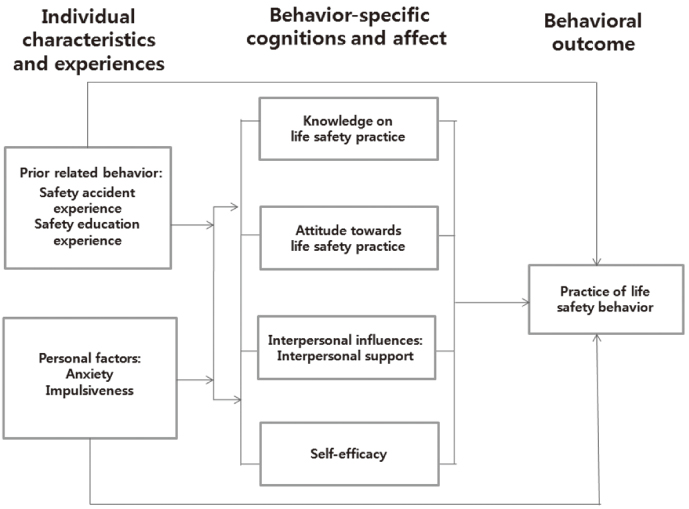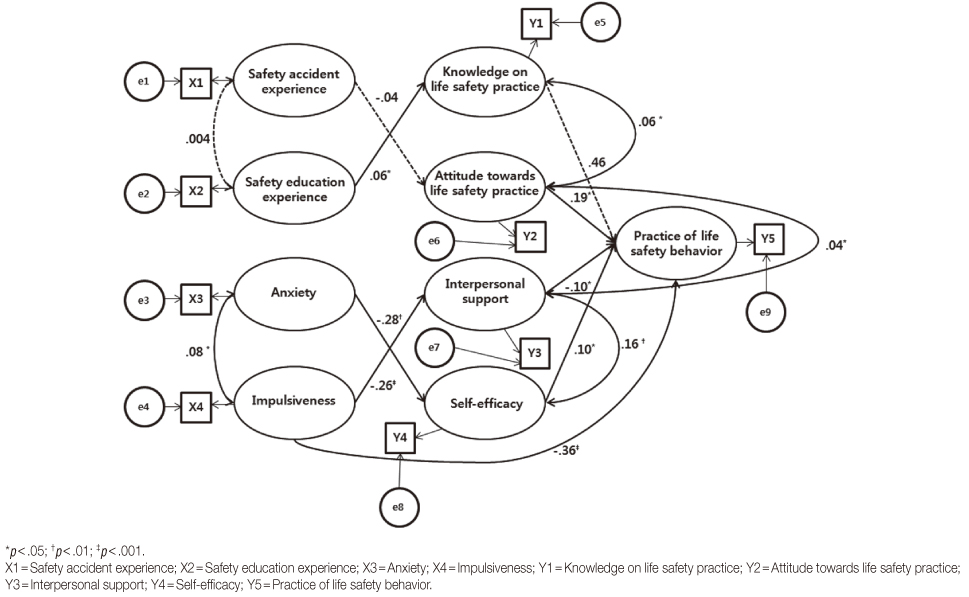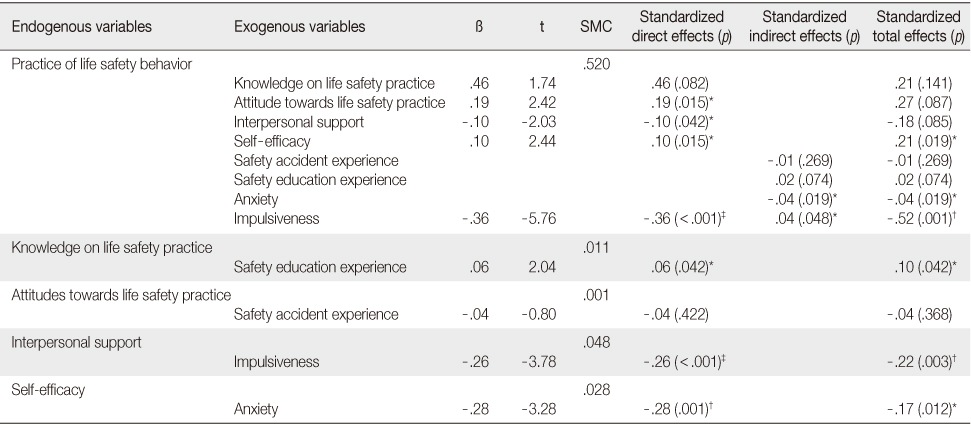Articles
- Page Path
- HOME > J Korean Acad Nurs > Volume 44(2); 2014 > Article
-
Original Article
- A Structural Model for the Practice of Life Safety Behavior in School-age Children
- Myung-Ock Chae
-
Journal of Korean Academy of Nursing 2014;44(2):119-128.
DOI: https://doi.org/10.4040/jkan.2014.44.2.119
Published online: April 30, 2014
Department of Nursing, Cheongju University, Cheongju, Korea.
- Address reprint requests to: Chae, Myung-Ock. Department of Nursing, Cheongju University, 298 Daeseong-ro, Sangdang-gu, Cheongju 360-764, Korea. Tel: +82-43-229-7922, Fax: +82-43-229-8969, 7702cmo@korea.com
© 2014 Korean Society of Nursing Science
This is an Open Access article distributed under the terms of the Creative Commons Attribution NoDerivs License. (http://creativecommons.org/licenses/by-nd/4.0/) If the original work is properly cited and retained without any modification or reproduction, it can be used and re-distributed in any format and medium.
Abstract
-
Purpose
- This study is an examination of the paths in which the primary factors of anxiety, impulsiveness, knowledge of life safety practice, attitudes towards life safety practice, interpersonal support, and self-efficacy from Pender's Health Promotion Model influence the practice of life safety behavior in school-age children.
-
Methods
- The sample consisted of 489 5th and 6th grade students recruited from five elementary schools in Seoul City and four provinces, South Korea. Data were analyzed using descriptive statistics, correlations, factor analysis, and structural equation modeling.
-
Results
- Attitudes towards life safety practice, interpersonal support, self-efficacy and impulsiveness directly influenced practice of life safety behavior. Anxiety did not have a direct influence on practice of life safety behavior, but indirectly affected it. In this modified model, 52.0% of the practice of life safety behavior was explained by the primary factors.
-
Conclusion
- To facilitate the practice life safety behaviors in late childhood, a positive attitude towards life safety needs to be developed along with decreasing impulsiveness and enhancing self-efficacy.
This manuscript is based on a part of the first author's doctoral dissertation from Ewha Womans University.
- 1. Bae JY. Development of the safety education program for children. Korean J Child Health Nurs. 2003;9(2):162–172.
- 2. Statistics Korea. 2011 annual report on the causes of death statistics [Internet]. Daejeon, Statistics Korea. 2012;cited 2012 November 19. Available from: http://kostat.go.kr/portal/korea/kor_nw/2/6/2/index.board?bmode=read&aSeq=260046
- 3. Kim SK, Kim Y, Lee HN. Report No.: 2010-95. Monitoring implementation of the UN convention on the rights of the child: Implementation monitoring report. Seoul: Ministry of Health & Welfare, Korea Institute for Health and Social Affairs, Korea Monitoring Center for Children's Rights; 2010.
- 4. Lee MS, Park KO. School safety education factors predicting injury prevalence among Korean adolescence. J Korean Soc Health Educ Promot. 2004;21(2):147–165.
- 5. Ministry of Health & Welfare. Support for children and youth [Internet]. Seoul, Ministry of Health & Welfare. 2012;cited 2012 December 12. Available from: http://www.mw.go.kr/front_new/jc/sjc0109mn.jsp?PAR_MENU_ID=06&MENU_ID=0609020403&page=1
- 6. Choi JS, Cho SC. Assessment of anxiety in children: Reliability and validity of revised children's manifest anxiety scale. J Korean Neuropsychiatr Assoc. 1990;29(3):691–702.
- 7. Yoon SH, Kim SJ. A study on the relativeness between safety knowledge and safety behavior of elementary school children. J Korean Soc Sch Health. 2012;25(1):39–50.
- 8. Pender NJ. Health promotion in nursing practice. 3rd ed. Stamford, CT: Appleton & Lange Inc; 1996.
- 9. Bae BR. Structural equation modeling with Amos 19: Principles and practice. Seoul: Chungram Books; 2011.
- 10. Reynolds CR, Richmond BO. Factor structure and construct validity of "what I think and feel": The revised children's manifest anxiety scale. J Pers Assess. 1979;43(3):281–283. http://dx.doi.org/10.1207/s15327752jpa4303_9ArticlePubMed
- 11. Barratt ES, White R. Impulsiveness and anxiety related to medical students' performance and attitudes. J Med Educ. 1969;44(7):604–607.ArticlePubMed
- 12. Lee HY, Kwon BA, Lee YA. The relationship of safety-accidents in school and personality: With special reference to impulsivity and extraversion-introversion. J Korean Soc Saf Educ. 2002;5(1):21–34.
- 13. Kim SJ. Development and evaluation of a safety education program for injury prevention in elementary school students. J Korean Acad Child Health Nurs. 2010;16(1):20–29. http://dx.doi.org/10.4094/jkachn.2010.16.1.20Article
- 14. Coughlan AK, Humphrey M. Presenile stroke: Long-term outcome for patients and their families. Rheumatol Rehabil. 1982;21(2):115–122.ArticlePubMed
- 15. Suh MJ. A study on factors influencing the state of adaptation of the hemiplegic patients. J Nurs Acad Soc. 1990;20(1):88–117.ArticlePDF
- 16. Kim SK, Kim Y. An oral health promotion behavior model for primary school children. J Korean Acad Dent Health. 2008;32(4):563–574.
- 17. Sherer M, Maddux JE, Mercandante B, Prentice-Dunn S, Jacobs B, Rogers RW. The self-efficacy scale: Construction & validation. Psychol Rep. 1982;51(2):663–671.ArticlePDF
- 18. Bagozzi RP, Yi Y. On the evaluation of structural equation models. J Acad Mark Sci. 1988;16(1):74–94. http://dx.doi.org/10.1007/BF02723327ArticlePDF
- 19. Jung CY, Choe RG. Statistical analysis using SPSSWin. 2nd ed. Seoul: Muyok Publisher; 1996.
- 20. Yu JP. The concept and understanding of structural equation modeling. Seoul: Hannarae Publishing Co; 2012.
- 21. Kim SJ, Lee JE, Song MK. Effect of the safety education on knowledge and attitude about injury prevention among elementary school children. Korean J Child Health Nurs. 2003;9(4):349–358.
- 22. Kim SJ, Lee JE, Kim KM, Park MO, Baek SS, Song MK, et al. Safety education needs and knowledge and attitude of injury prevention of elementary school children. Korean J Child Health Nurs. 2003;9(3):250–258.
- 23. Kwon SS. Development and effect evaluation of safety education program for higher grade students of elementary school. J Korean Soc Sch Health. 2005;18(2):45–61.
- 24. Kim U, Park YS, Park D. Adolescents' causal attribution of accidents and their cognitive representation safety and safety efficacy. Korean J Psychol Soc Issues. 2001;7(2):39–63.
- 25. Russell KM, Champion VL. Health beliefs and social influence in home safety practices of mothers with preschool children. Image J Nurs Sch. 1996;28(1):59–64.ArticlePubMed
- 26. Kim CH, Park YS. The relationship between the personality of elementary school students and the safety accidents in the school. J Korean Soc Sch Health Educ. 2003;4:1–20.
- 27. Hong YK, Lee KS, Song HJ, Baek MS. The effect of self focused attention, trait anxiety and self-efficacy on social phobia. J Spec Educ Rehabil Sci. 2012;51(1):267–286.
- 28. Kim SJ, Lee JE. The effect of safety education on accident proneness prospect in preschooler. Korean J Child Health Nurs. 2000;6(3):372–386.
- 29. Lee I. The behavior analysis of home injury prevention based on the model of family health protection. J Korean Community Nurs. 2001;12(2):406–416.
- 30. Hockenberry MJ, Wilson D. Kim YH Kwon BS Nam HK Ahn MS Yang YO Oh SE . Wong's essentials of pediatric nursing. 8th ed. St. Louis, MO: Mosby Elsevier; 2009.
REFERENCES

df=Degree of freedom; GFI=Goodness fit index; SRMR=Standardized root mean squared residual; RMSEA=Root-mean square error of approximation; CI=Confidence interval; NFI=Normed fit index; CFI=Comparative fit index; TLI=Tucker-lewis index; PGFI=Parsimoniuous goodness of fit index; PNFI=Parsimonious normed of fit index; AIC=Akaike information criterion; BIC=Bayes information criterion; CAIC=Consistent akaike information criterion.
Figure & Data
REFERENCES
Citations

- A Study of Effect of Disability Prevention Program Acquired by People with Disabilities are Performed : centered on Elementary School Students
Yeon-Jung Kim
Journal of Digital Convergence.2016; 14(5): 369. CrossRef - Effects of Academic Stress and Self-Esteem on Practice of Life Safety Behaviors in School-Age Children
Myung-Ock Chae
Journal of the Korea Academia-Industrial cooperation Society.2015; 16(4): 2713. CrossRef


Figure 1
Figure 2
Descriptive Statistics of Study Variables after Exploratory Factor Analysis (N=489)
Model Fitness Indexes of the Hypothetical Model and Modified Model
df=Degree of freedom; GFI=Goodness fit index; SRMR=Standardized root mean squared residual; RMSEA=Root-mean square error of approximation; CI=Confidence interval; NFI=Normed fit index; CFI=Comparative fit index; TLI=Tucker-lewis index; PGFI=Parsimoniuous goodness of fit index; PNFI=Parsimonious normed of fit index; AIC=Akaike information criterion; BIC=Bayes information criterion; CAIC=Consistent akaike information criterion.
Direct and Indirect Effects of Study Variables in the Modified Model (N=489)
*p<.05; †p<.01; ‡p<.001; ß=Standardized regression coefficients; SMC=Squared multiple correlation.
df=Degree of freedom; GFI=Goodness fit index; SRMR=Standardized root mean squared residual; RMSEA=Root-mean square error of approximation; CI=Confidence interval; NFI=Normed fit index; CFI=Comparative fit index; TLI=Tucker-lewis index; PGFI=Parsimoniuous goodness of fit index; PNFI=Parsimonious normed of fit index; AIC=Akaike information criterion; BIC=Bayes information criterion; CAIC=Consistent akaike information criterion.
*
 KSNS
KSNS
 E-SUBMISSION
E-SUBMISSION




 Cite
Cite

